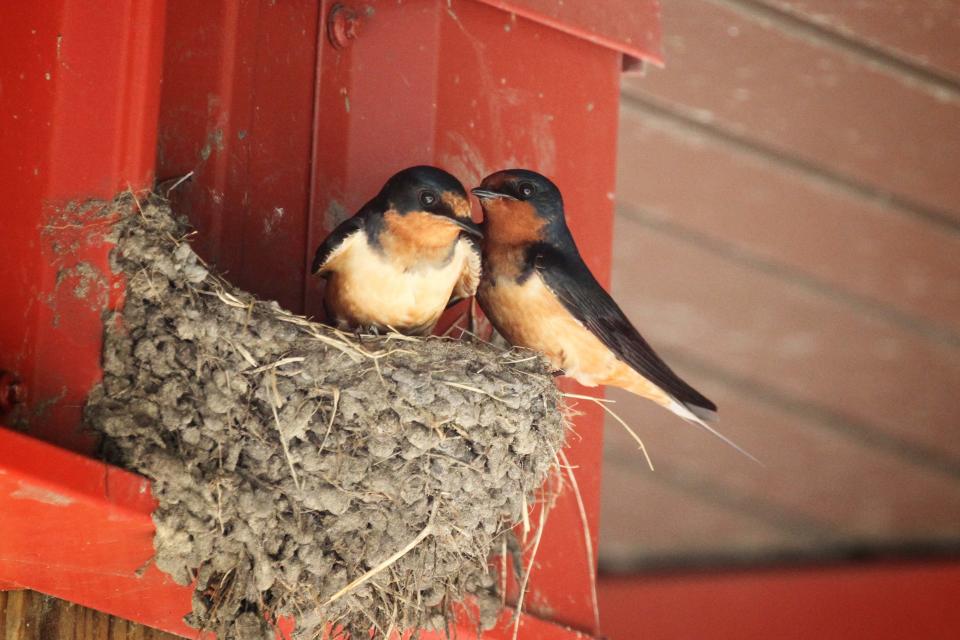Meet the barn swallows, the small birds that aid us with pest control every year
The most wide-spread members of the swallow family, barn swallows wing their way throughout the world, breeding generally in the Northern Hemisphere and wintering throughout most of the Southern Hemisphere.
Their migration certainly qualifies them long-distance fliers.
Because people generally encourage these handsome, insect-eating birds to nest nearby, barn swallows have evaded the now-common plight of severe avian decline. Estimates indicate a relatively gentle cumulative decline of about 25 percent over the past 55 years. Indeed, as human populations expanded across continents worldwide, barn swallows followed, thus significantly expanding their breeding range.
While barn swallows once nested almost entirely in caves, they, like purple martins, have come to prefer man-made structures. Leave the garage or yard shed door or window open, and barn swallows may well move in, pasting their cup-shaped mud-and-grass nests to whatever shelf or vertical surface offers the best protection for raising a family.
More: Here's what you should know about the blue jays in your backyard
Given the absence of easy access to the interior of barns, sheds, or garages, they select sites like the undersides of eaves or bridges, wharfs, and culverts.
While some folks find barn swallow nests objectionable on porches or vestibules where the growing mess becomes offensive to folks coming to and going from the residence, most residents welcome the birds for their huge insect appetites. Barn swallows absolutely love flies of all types but readily take beetles, bees, wasps, ants, moths, and other flying insects -- mostly caught on the wing. They seem to prefer, however, big bugs to swarms of smaller bugs.
What fantastic natural pest control!
Their preferred diet also dictates their famously graceful, acrobatic flights as they dart and dive after flying insects.

Typically, they fly low, sometimes only inches above the ground or water, the best locations, of course, for low-flying insect prey.
Although barn swallows never come to feeders (they don't eat seed or suet), they do regularly seek out grit and small pebbles. So one way to attract these cobalt blue-backed acrobats with their streaming forked tails is to scatter crushed oyster shells or baked, crushed eggshells on a solid surface like a concrete driveway. Scientists believe the birds' regular consumption of grit serves two purposes: first, to aid their digestion of insects, many of which have tough exoskeletons. and second, to provide necessary calcium to their diets, especially for egg-laying females.
We have barn swallows to thank for another reason. Sadly, during in the Victorian era, milliners created women's hats using lavish arrays of bird feathers -- sometimes entire birds themselves. So it was with barn swallows, the trade threatening populations especially of many birds, including great egrets. Unknowing (or uncaring?) women of means snatched up the pricey hats as a matter of status and elegance, a practice now, of course, considered abhorrent.
More: Love the birds in your yard? Here are 4 things to avoid so you can keep them healthy
Some conservation-minded women, however, outraged by the slaughter, protested vehemently, their actions ultimately resulting in protective laws, including the International Migratory Bird Treaty Act of 1918. Now. more than 100 years later, the law continues to protect birds not only in the US but also in Canada, Mexico, Japan, and Russia.
The same uproar also prompted naturalist George Grinnell to write the now-famous editorial published in the 1886 "Forest and Stream" magazine decrying the practice. Ultimately, his editorial led to the founding of the first chapter of what became the National Audubon Society.
For more information about birds and bird habitat, see Sharon Sorenson's books How Birds Behave, Birds in the Yard Month by Month, and Planting Native to Attract Birds to Your Yard. Follow daily bird activity on Facebook at SharonSorensonBirdLady, or email her at chshsoren@gmail.com.
This article originally appeared on Evansville Courier & Press: What purpose does a barn swallow serve?

